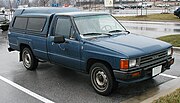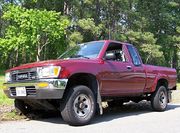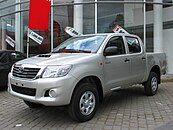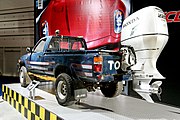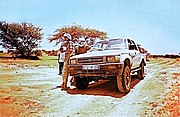Toyota Hilux
| Toyota Hilux | |
|---|---|
 | |
| Overview | |
| Manufacturer | Toyota Motor Corporation Toyota Motor Thailand Co.,Ltd. |
| Also called | Toyota Pickup (US) |
| Production | Mar 1968–present |
| Body and chassis | |
| Platform | Toyota "N" |
| Chronology | |
| Predecessor | Toyopet Light (Stout) Hino/Toyota Briska[1] |
| Successor | Toyota Tacoma (Japan and North America) |
The Toyota Hilux is a series of compact pickup trucks produced and marketed by the Japanese manufacturer Toyota. Most countries used the Hilux name for the entire life of the series but in North America, the Hilux name was retired in 1976 in favor of Truck, Pickup Truck, or Compact Truck. In North America the popular option package, the SR5 (Sport Rally 5-Speed), was colloquially used as a model name for the truck, even though the option package was also used on other Toyota models like the Corolla. In 1984, the Trekker, the camper version of the Hilux, was renamed as the 4Runner in Australia and North America, and as the Hilux Surf in Japan. In 1995, Toyota introduced a new pickup model, the Tacoma in North America, discontinuing the Hilux/Pickup there. The 4Runner is now a full SUV, and the more recent models do not resemble the Tacoma.
As of 2014 the Toyota hilux is available worldwide, except Japan, United States, Canada, North Korea, and South Korea
First generation (1968-1972)
| First generation N10 series | |
|---|---|
 | |
| Overview | |
| Production | Mar 1968 – Apr 1972 |
| Assembly | Hamura, Tokyo, Japan |
| Body and chassis | |
| Body style | 2-door truck |
| Layout | FR layout |
| Powertrain | |
| Engine | |
| Transmission | 4-speed manual |
The Hilux started production in March 1968[2] as the RN10 in short-wheelbase form with a 1.5 L engine, producing 77 PS (57 kW) in Japanese market spec, and in Japan it was available at Toyota Japan dealership retail chains called Toyota Store and Toyopet Store. The modification to the engine was enough for a claimed 130 kilometres per hour (81 mph)* top speed.[3] This was upgraded to a 1.6 L inline-four engine in February 1971.
In April 1969, a long-wheelbase version was added to the range. The short-wheelbase version also continued in production for many more years. The long-wheelbase version was not sold on the North American market until 1972. The Hilux was offered as an alternative to the Toyota Crown, Toyota Corona, and Toyota Corona Mark II based pickup trucks in Japan, as the Crown, Corona, and Corona Mark II were repositioned as passenger sedans.
In spite of the name "Hilux", it was a luxury vehicle only when compared to the Stout. The Hilux was engineered and assembled by Hino Motors to replace the earlier vehicle that the Hilux was derived from, called the Briska[4] in the niche beneath the larger and older Stout – it replaced the Stout fully in some markets. For the North American market, the only body style was a regular cab short bed and all were rear-wheel drive. It used a typical truck setup of A-arms and coil springs in front and a live axle with leaf springs in back. A four-speed manual transmission was standard.
Global markets:
North American markets:
- 1969: 1.9 L (1,897 cc) 3R I4, 63 kW (86 PS; 84 hp)
- 1970–1971: 1.9 L (1,858 cc) 8R SOHC I4, 72 kW (98 PS; 97 hp)
- 1972: 2.0 L (1,968 cc) 18R SOHC I4, 81 kW (110 PS; 109 hp)
Second generation (1972-1978)
| Second generation N20 series | |
|---|---|
 | |
| Overview | |
| Production | May 1972 – Jul 1978 |
| Assembly | Toyota City, Japan Hamura, Tokyo, Japan (Hino) |
| Body and chassis | |
| Body style | 2-door truck |
| Layout | FR layout |
| Powertrain | |
| Engine | 1.6 L 12R I4 (RN20/25) 2.0 L 18R I4 (RN22) 2.2 L 20R I4 |
| Transmission | 4/5-speed manual |
| Dimensions | |
| Wheelbase |
|
| Length | 4,275 mm (168.3 in) (N20) 4,680 mm (184 in) (N25) |
| Width | 1,580 mm (62 in) |
In May 1972,[2] the 1973 model year Hilux was released as the RN20. A more comfortable interior was specified along with exterior updates. A 2.25 m (7.4 ft) "long bed" was an option for the first time in North America, although such a version had been available worldwide since April 1969.[2] This received the "RN25" chassis code.[5] The 2.0 liter 18R engine became available in late 1973 in Japan as well, albeit only in conjunction with a three-speed automatic transmission.[6]
The Hilux was radically redesigned in 1975 to be larger and with increased standard equipment. In North America the new version also meant the introduction of the considerably larger (2.2 L) 20R engine and the SR5 upscale trim package. A five-speed manual transmission became optional. In North America, the Hilux name was fully phased out in favor of "Truck" by that year, having been dropped from brochures and advertising starting in 1973.
Global markets:
- 1972–1978: 1.6 L (1587 cc) 12R I4, 83 PS (61 kW)[5]
- 1973–1978: 2.0 L (1968 cc) 18R I4, 105 PS (77 kW)[6][2]
North American markets:
- 1973–1974: 2.0 L (1968 cc) 18R SOHC I4, 81 kW (110 PS; 109 hp)
- 1975–1978: 2.2 L (2189 cc) 20R SOHC I4, 72 kW (98 PS; 97 hp)
Third generation (1978-1983)
| Third generation (N30/40) | |
|---|---|
 | |
| Overview | |
| Also called | Toyota Pickup (US) |
| Production | Aug 1978–1983 |
| Assembly | Toyota City, Japan Hino Motors – Hamura, Tokyo, Japan |
| Body and chassis | |
| Body style | 2 and 4-door truck |
| Layout | Front engine, rear-wheel drive / four-wheel drive |
| Related | Toyota Trekker |
| Powertrain | |
| Engine | 1.6 L 12R I4 1.8 L I4 2.0 L 18R I4 2.2 L 20R I4 2.4 L 22R I4 2.2 L L diesel I4 |
| Transmission | |
| Dimensions | |
| Wheelbase | |
The redesigned Hilux was introduced in August 1978,[2] with a 4WD variant introduced in Jan 1979.[2] The 4WD variant – not offered with any engines smaller than the two-litre "18R" – featured some common technology with the larger Toyota Land Cruiser.[4] Production of the four-wheel drives stopped in July 1983, but some 2WD variations continued in parallel with the next generation.[2] The L series diesel engine was offered on the 2WD variants from September 1979 and the 4WD variants in March 1983.[2] In Japan, the Hilux was joined with the all new Toyota MasterAce, sharing load carrying duties, and sold at Toyota Store locations alongside the Hilux.
In North America the Hilux saw the use of four-wheel drive. It had a solid front axle and leaf suspension. The body saw a redesign that included single round headlights and a less complex body. This new 4WD setup featured a gear driven RF1A transfer case. This transfer case is unique in that its low-range reduction portion can be replicated, using what some refer to as a dual or triple transfer case. This results in a much lower overall gear ratio.[8] It was the first Hilux available with an automatic transmission.
In 1981 a vehicle development agreement was established between Toyota, Winnebago Industries and two other aftermarket customizers. This was to allow Toyota to enter the SUV market in North America. The vehicles which resulted from this collaboration were the Trekker (Winnebago), Wolverine, and the Trailblazer (Griffith). All three used the Hilux 4×4 RV cab and chassis, and an all-fiberglass rear section (the Trailblazer had a steel bed with a fiberglass top). There were at least 1,500 Trekkers, 400 Trailblazers and an unknown number of Wolverines sold in North America. Research and development work on the Trekker led to the development of the 4Runner/Hilux Surf, which was released in 1984.
Toward the end of the SR5's production run (1983½ model year), Toyota introduced the luxury Mojave for the US market as a limited-production (3,500 units) model with options not available on any other Toyota pickup.[9] List priced at US$8,308,[9] it featured bucket seats, two-speaker multiplex radio, chrome front and rear bumpers, and no Toyota logo on either the grille or tailgate.[9] Cruise control, power steering, and air conditioning were optional.[9] It was powered by the SR5's standard 2.4 L (150 cu in) inline four.[9]
Engines:
- 1978-1983: 1.6 L (1587 cc) 12R SOHC I4, 80 PS (59 kW) at 5200 rpm and 12.5 kg⋅m (123 N⋅m) of torque at 3000 rpm (RN30/40)[7]
- 1981–1983: 1.8 L preflow, 4-speed manual (Australia)
- 1978–1980: 2.2 L (2189 cc) 20R SOHC I4, 67 kW (91 PS; 90 hp) at 4800 rpm and 165 N⋅m (122 lb⋅ft) of torque at 2400 rpm
- 1981–1983: 2.4 L (2366 cc) 22R SOHC I4, 98 PS; 97 hp (72 kW) at 4800 rpm and 175 N⋅m (129 lb⋅ft) of torque at 2800 rpm
- 1981–1983: 2.2 L diesel I4, 46 kW (63 PS; 62 hp) at 4200 rpm and 126 N⋅m (93 lb⋅ft) of torque (SR5 long bed only in the US), LN30/40
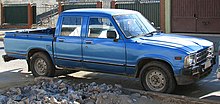
Fourth generation
| Fourth generation N40 series | |
|---|---|
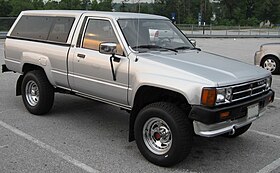 | |
| Overview | |
| Also called | Toyota 1 Ton |
| Production | Aug 1983–1988 |
| Model years | 1984–1989 |
| Assembly | |
| Body and chassis | |
| Body style | 2 and 4-door truck |
| Layout | Front engine, rear-wheel drive / four-wheel drive |
| Related | |
| Powertrain | |
| Engine | |
| Transmission |
|
| Dimensions | |
| Wheelbase |
|
| Length |
|
| Width |
|
| Height |
|
| Curb weight | 1,270 kg (2,800 lb) |
The August 1983 redesign (sold as model year 1984 vehicles in North America) introduced the Xtracab, two-row extended cab option. These "1984" models carried over the carbureted 22R engine while model year 1984 also saw the introduction of the fuel injected 22R-E. Two diesel engines were also offered, the 2L and the turbocharged 2L-T. The diesels were discontinued in the U.S. after the 1986 model year, this was due to higher performance expectations from customers and the wide availability of inexpensive gasoline. The next year saw the introduction of a turbocharged option, the 22R-TE, perhaps due to increasing competition from Nissan who already offered a V6 truck at this time. The solid front axle was swapped out for an independent front suspension/torsion bar setup in the 4×4 model in 1986, and optional automatic front locking hubs and an electronic transfer case was added as well. A V6 engine was introduced in 1988. The Hilux-based 4Runner which made its entry in Australia, North America and the United Kingdom was based on this generation Hilux; in some other markets, such as Japan, it was called the Hilux Surf.
Toyota introduced a new generation of the Hilux in most markets in late 1988 but the fourth generation remained in production until 1997 in South Africa. Toyota says this was due to South African "content laws" which made it cheaper to continue to produce the fourth generation Hilux, rather than to retool the plant for the fifth generation.[10]
Engines:
| Calendar years | capacity | code | features | power | torque | comments |
|---|---|---|---|---|---|---|
| 1983–1987 | 2,366 cc | 22R | I4 SOHC | 72 kW (98 PS; 97 hp) at 4800 rpm | 174 N⋅m (128 lb⋅ft) at 2800 rpm | |
| 1983–1985 | 2,188 cc | L | I4 Diesel | 46 kW (63 PS; 62 hp) at 4200 rpm | 126 N⋅m (93 lb⋅ft) at 2800 rpm | SR5 long bed only |
| 1983–1984 | 2,466 cc | 2L | I4 Diesel | 62 kW (84 PS; 83 hp) at 4200 rpm | 165 N⋅m (122 lb⋅ft) at 2400 rpm | |
| 1986–1988 | 2,466 cc | 2L-T | I4 Diesel FI turbo | 69 kW (94 PS; 93 hp) at 4000 rpm | 216 N⋅m (159 lb⋅ft) at 2400 rpm | |
| 1983–1988 | 2,366 cc | 22R-E | I4 SOHC FI | 78 kW (106 PS; 105 hp) at 4800 rpm | 185 N⋅m (136 lb⋅ft) at 2800 rpm | |
| 1985–1986 | 2,366 cc | 22R-TE | I4 SOHC FI turbo | 101 kW (137 PS; 135 hp) at 4800 rpm | 234 N⋅m (173 lb⋅ft) at 2800 rpm | |
| 1987– | 2,958 cc | 3VZ-E | V6 FI | 112 kW (152 PS; 150 hp) at 4800 rpm | 244 N⋅m (180 lb⋅ft) at 2400 rpm | |
| 1983– | 1,626 cc | 1Y | I4 | |||
| 1983– | 1,998 cc | 3Y | I4 |
Fifth generation
| Fifth generation N50 series | |
|---|---|
 | |
| Overview | |
| Also called | Toyota 4×2 Toyota 4×4 Volkswagen Taro |
| Production | 1988–1998 |
| Assembly | Tahara, Aichi, Japan Hamura, Japan Zárate, Argentina Fremont, California Envigado, Colombia Santa Rosa, Laguna, Philippines, Christchurch, New Zealand Hanover, Germany (VW) |
| Body and chassis | |
| Body style | 2-door, 4-door truck |
| Layout | Front engine, rear-wheel drive / four-wheel drive |
| Related | 4Runner/Hilux Surf Prado Classic |
| Powertrain | |
| Engine | 1.8 L 2Y-U I4 2.4 L 22R-E I4 3.0 L 3VZ-E V6 2.4 L 2L diesel I4 2.8 L 3L diesel I4 |
| Transmission | four-speed manual five-speed manual four-speed automatic |
| Dimensions | |
| Wheelbase | regular cab: 2,616 mm (103.0 in) regular cab long bed: 2,850 mm (112.2 in) Xtracab: 3,086 mm (121.5 in) Xtracab V6: 3,096 mm (121.9 in) |
| Length | regular cab: 4,435 mm (174.6 in) regular cab long bed: 4,724 mm (186.0 in) Xtracab: 4,905 mm (193.1 in) DLX regular cab long bed 4WD: 4,719 mm (185.8 in) DLX regular cab 4WD: 4,430 mm (174.4 in) |
| Width | 1,689 mm (66.5 in) |
| Height | 1988–91 regular cab: 1,544 mm (60.8 in) 1988–91 regular cab long bed: 1,539 mm (60.6 in) 1988–91 Xtracab 2WD: 1,549 mm (61.0 in) 1988–91 regular cab long bed 4WD: 1,704 mm (67.1 in) 1988–91 Xtracab 4WD: 1,709 mm (67.3 in) 1991–97 regular cab: 1,590 mm (62.6 in) 1991–97 regular cab: 1,595 mm (62.8 in) 1991–97 Xtracab 4WD: 1,755 mm (69.1 in) 1991–97 regular cab 4WD: 1,750 mm (68.9 in) |
The next redesign, in 1988, produced a longer-wheelbase option, 3,099 mm (122 in) rather than 2,616 mm (103 in) for the regular wheelbase. Its one-piece cargo-box walls eliminated the rust-prone seams that were found in earlier models. The V6 Xtracab SR5 earned Motor Trend magazine's Truck of the Year award that year. The Xtracabs now featured more room behind the front seats than the last generation which allowed optional jump-seats for rear passengers, a feature more in line with competitors of the time.
In 1991, American production began at the NUMMI plant in Fremont, California (the VIN on these cars starts with '4T'), however some trucks sold in the United States during the 91–95 model years were still manufactured in Japan (VIN starts with 'JT').
The Hilux received a minor facelift in 1991 (for the 1992 model year), which was a minor grill change and the new Toyota emblem that had been recently adopted.
It was during this generation that Toyota discontinued the Hilux in the United States, replacing it with the new Tacoma in 1995.
Engines:
- 1988–1995: 1.8 L (1,812 cc) 2Y-U I4, 58 kW (79 PS; 78 hp) at 5,000rpm 140 N⋅m (100 lb⋅ft) at 3,200rpm
2Y I4, 61 kW (83 PS; 82 hp) at 4,800rpm 140 N⋅m (100 lb⋅ft) at 2,800rpm (export markets)[11]
- 1989–1995: 2.4 L (2,366 cc) 22R-E SOHC EFI I4, 84 kW (114 PS; 113 hp) at 4,600 rpm and 192 N⋅m (142 lb⋅ft) at 3,400 rpm
- 1989–1995: 3.0 L (2,958 cc) 3VZ-E V6, 112 kW (152 PS; 150 hp) at 4,800 rpm
- 1989–1997: 2.4 L (2,446 cc) 2L diesel I4, 61 kW (83 PS; 82 hp) at 4,200 rpm and 165 N⋅m (122 lb⋅ft) at 2,400 rpm[12]
- 2.8 L (2,779 cc) 3L diesel I4, 67 kW (91 PS; 90 hp) at 4,000 rpm and 188 N⋅m (139 lb⋅ft) at 2,400 rpm
Volkswagen built and marketed them under the Volkswagen Taro name from February 1989 to March 1997.
South America
For sales in Colombia and Venezuela, the Hilux was produced in Colombia from 1994 to 1998 by the SOFASA company (only the petrol engine 2.4 l) and Ecuador). For sales in Argentina, Brazil, and Uruguay, the Hilux was produced in Argentina from 1997 through 2005 (Zárate Plant – both petrol and diesel engines). For sales in Bolivia, Chile, Paraguay, Peru, the Hilux was imported from factories in Japan from 1989 to 1997 (petrol and diesel engines).
South American markets:
- single cab chassis (2WD, 4WD petrol engines) (Colombia and Ecuador)
- single cab long bed (2WD,4WD, petrol and diesel engines) (all South American countries; diesel engine not available in Colombia, Ecuador and Venezuela)
- xtra cab (2WD, 4WD, petrol) (Only Bolivia)
- crew cab (2WD,4WD, petrol and diesel engines)(All South American countries; Diesel engine not available in Colombia, Ecuador and Venezuela)
Sixth generation
| Sixth generation N60 series | |
|---|---|
 | |
| Overview | |
| Production | 1997–2005 |
| Assembly | Hino Motors, Hamura, Japan Envigado, Colombia Santa Rosa, Laguna, Philippines Samut Prakan, Thailand Cumaná, Venezuela |
| Body and chassis | |
| Body style | 2-door truck 4-door truck |
| Layout | Front engine, rear-wheel drive / four-wheel drive |
| Related | 4Runner/Hilux Surf TC Pickup |
| Powertrain | |
| Engine | 2.0 L I4 2.4 L I4 2.7 L I4 2.4 L D-4D turbo diesel 2.5 L D-4D turbo diesel 3.0 L diesel I4 |
| Transmission | 5-speed manual 4-speed automatic |
| Dimensions | |
| Wheelbase | Regular Cab: 2,850 mm (112.2 in) Extended Cab: 3,090 mm (121.7 in) Crew Cab: 2,855 mm (112.4 in) |
| Length | Regular Cab: 4,690 mm (184.6 in) Extended Cab: 5,035 mm (198.2 in) Crew Cab: 4,790 mm (188.6 in) |
| Width | Regular Cab & All 2WD Models: 1,665 mm (65.6 in) Crew Cab & Extended Cab: 1,790 mm (70.5 in) |
| Height | 4WD Regular Cab/Extended Cab: 1,775 mm (69.9 in) 4WD Crew Cab: 1,795 mm (70.7 in) 2WD Regular Cab: 1,600 mm (63.0 in)/1,650 mm (65.0 in) 2WD Extended & Crew Cab:1,695 mm (66.7 in) |
Engines:
- 1998-2001 2.0 L (1,998 cc)1RZ-E 8 Valve SOHC I4 (Hilux 'Workmate' models in Australia) (4×2)
- 1995–2004 2.4 L (2438 cc) 2RZ-FE 16-valve DOHC I4, 106 kW (144 PS; 142 hp) (4×2)
- 1995–2004 2.7 L (2693 cc) 3RZ-FE 16-valve DOHC I4, 112 kW (152 PS; 150 hp) (4×4)
- 1995–2004 3.4 L 5VZ-FE 24-valve DOHC V6, 142 kW (193 PS; 190 hp)
South America
The Hilux was produced in Colombia for sales in Colombia, Venezuela, and Ecuador from 1998 to 2005 by the SOFASA company (with only petrol engines 2.7 L). In Venezuela and Ecuador, the single-cab 2WD chassis/long bed is called the Stout II). For sales in Bolivia, Chile, Paraguay, Peru, it was imported from Japan from 1998 through 2004 (petrol engined 2.7 L, and diesel engined 2.8 L). This model was not sold in Argentina or Brazil because the fifth generation Hilux had received a redesign and upgrade.
South American markets:
- single cab chassis (2WD, 4WD petrol engines) (for sales in Colombia and Ecuador)
- single cab long bed (2WD,4WD, petrol and diesel engines) (all South American countries)
- Xtracab (4WD, petrol and diesel engines) (in Bolivia only)
- crew cab (2WD,4WD, petrol and diesel engines)(all South American countries) (Named the Hilux Millenium from 2002 through the present)
Thailand
Toyota shifted production from the Hilux Mighty-X (fifth generation) to the Hilux Tiger (sixth generation) in the late 1990s and made it the global export hub. The Thailand-made Hilux Tiger went through the following versions:
- 1998–1999: Hilux Tiger with the 3.0l 5L engine
- 2000–2001: Hilux Tiger with the 3.0l 5L-E EFI engine
- 2001: Hilux Tiger with 1KZ engine (short lived replaced right away with D4D engine)
- Late 2001 – late 2004: Hilux Tiger SportCruiser with D4D engine[13]
In 2005, Toyota ceased production of the Hilux truck for the Japanese market. This was the last generation Hilux to be available (or built) in Japan.
-
1997–2001 Toyota Hilux (RZN149R) 2-door utility, Australia
-
Pickup 4WD Wide Extra cab Sports 2.7 L (RZN174H, Japan)
-
Pickup 4WD Wide Extra cab Sports 2.7 L (RZN174H, Japan
-
2001–2004 (before change to single glass in front doors)
(RZN149R, Australia) -
2002–2005 Toyota Hilux SR5 4-door utility
(VZN167R, Australia) -
Post facelift
Pickup 4WD Wide Double cab Sports 2.7 (RZN169H, Japan)
Seventh generation
| Seventh generation N70 series | |
|---|---|
 | |
| Overview | |
| Production | 2005–present |
| Assembly | Zarate, Argentina Cumaná, Venezuela Karachi, Pakistan Chachoengsao, Thailand[14][15] Samut Prakan, Thailand Durban, South Africa Guangzhou, China |
| Body and chassis | |
| Body style | 2-door truck 4-door truck |
| Layout | Front engine, rear-wheel drive / four-wheel drive |
| Related | Fortuner Innova |
| Powertrain | |
| Engine | 2.0 L 100 kW (134 hp) I4 1TR-FE 2.5 L 75 kW (101 hp) I4 2KD-FTV turbo diesel only 2.5 L 88 kW (118 hp) I4 2KD-FTV intercooled turbo diesel 2.5 L 106 kW (142 hp) I4 2KD-FTV intercooled VN turbo diesel 2.7 L 118 kW (158 hp) I4 2TR-FE 3.0 L 121 kW (162 hp) I4 1KD-FTV intercooled VN turbo diesel 4.0 L 176 kW (236 hp) 1GR-FE V6 |
| Transmission | 5-speed manual 4-speed automatic 5-speed automatic |
| Dimensions | |
| Wheelbase | Single Cab: 2,750 mm (108.3 in) 3,085 mm (121.5 in) |
| Length | Regular Cab: 4,975 mm (195.9 in) Extended Cab: 5,255 mm (206.9 in) Crew Cab: 5,130 mm (202.0 in) |
| Width | Regular Cab & All 2WD Models: 1,760 mm (69.3 in) Crew Cab & Extended Cab: 1,835 mm (72.2 in) |
| Height | 4WD Regular Cab: 1,795 mm (70.7 in) 4WD Crew Cab & Extended Cab: 1,810 mm (71.3 in) 2WD Regular Cab: 1,680 mm (66.1 in) 2WD Extended & Crew Cab: 1,695 mm (66.7 in) |
Both the Tacoma and the Hilux were updated in 2005. The Tacoma was based on the new 4Runner chassis, while the Hilux rides on a refreshed version of the ladder frame found on previous versions. The new Hilux has increased in size and is now classified as a mid-size pick up. The Tacoma had a new 4.0 L V6 engine that produces 176 kW (236 hp) and 361 N⋅m (266 lb⋅ft) of torque. Its design was very similar to the 4Runner.
Hilux models sold in Australian, Middle Eastern, and Asian markets are built and assembled in Thailand, where the vehicle is called the Hilux Vigo, or simply Vigo. For the European and South African markets the Hilux is built in Durban, South Africa. As of December 2009, it is the best selling vehicle in South Africa. Those sold in South America are made in Argentina, as with the previous generation Hilux.[16] In Asia, the Hilux Vigo platform was used as the basis for Toyota's IMV program which spawned the Innova MPV and Fortuner SUV/PPV.

In Malaysia, the Hilux is only available in 2.5 L with the option of single cab or double cab.[citation needed] The double cab model has an automatic transmission variant. It uses the same engine as other Asian countries (in-line, 4-cylinder, 16-valve, DOHC Turbo Diesel with common rail direct injection), however engines used in Malaysia differ in their maximum output of 75 kW (101 hp) at 3600 rpm and maximum torque of 260 N⋅m (192 lbf⋅ft) at 1600–2400 rpm.
In Singapore, the Hilux is available as a single cab with the 2.5 L engine or a double cab with the 3.0 L engine. However, the engines are built in Japan (where they are also used in the Prado) instead of Argentina.[citation needed] Notable fleet customers include private taxi operators, for whom the double cab model offers additional load space versatility, and the Singapore Police Force and Pakistan Police, which employs it as a patrol vehicle.
The Hilux will be built in Guangqi Toyota Automobile in Guangzhou for the Chinese market. The models for China will be 4.0 L with the option of single cab or double cab. It uses the same engine as Australia (V6, 24-valve, DOHC), however engines used in China has been tuned up to the maximum output of 246 kW (330 hp) at 6500 rpm and maximum torque of 405 N⋅m (299 lbf⋅ft) at 4000 rpm, and is mated to a 5-speed automatic transmission. China is the only Asian country to get the V6 engine.
A Hilux entered in the 2012 Dakar Rally by the Imperial Toyota team of South Africa managed to capture third place despite having little modifications from the production model and being up against factory supported teams.[citation needed]
Engines (markets):
- 2005 2.0 L gasoline VVT-i DOHC I4 (South Africa, Indonesia and Middle East)
- 2005 2.5 L diesel D-4D DOHC I4, 76 kW (102 hp) – 107 kW (145 PS; 143 hp) (Asia, Europe, South Africa, South America)
- 2005 2.7 L gasoline VVT-i DOHC I4, 119 kW (162 PS; 160 hp) (Australia, Arabian Peninsula, The Philippines, South Africa, Venezuela, USA)
- 2005 3.0 L diesel D-4D DOHC I4, Turbodiesel, commonrail 16-valve direct injection, 121 kW (165 PS; 162 hp) (Asia, South Africa, South America, Australia, Europe). This version is made at Toyota's facility in Zárate, Argentina.
- 2005 4.0 L gasoline VVT-i DOHC V6, 170 kW (231 PS; 228 hp) – 176 kW (236 hp) (Australia, South Africa, Venezuela, China)
- 2008 4.0 L Supercharged DOHC V6 225 kW (306 PS; 302 hp) (Australia only, TRD edition)
2008 Facelift
A facelifted version of the Hilux was unveiled by Toyota's Malaysian distributors, UMW Toyota Motor, in August 2008. Toyota has released a left hand drive facelifted Hilux Vigo in August 2008 while a right hand drive facelifted model is expected to be released in September 2008.[17] These facelifted models were introduced to the Philippines in October 2008.
Toyota also introduced a rear access system called "Smart Cab" to replace all Xtra Cab models in E and G grade. The Smart Cab models are only for the Thailand domestic market.[citation needed]
2011 Facelift
On 13 July 2011, Toyota announced that the Hilux would receive an upgrade, including a redesigned front end and other external styling changes, changes to the interior and a new turbocharged diesel engine capable of 106 kW (142 hp) and 343 N⋅m (253 lb⋅ft) of torque, as well as lower fuel consumption compared to the previous model.[18] This update was initially launched in Thailand.[19] The Thailand version of 2012 Toyota Hilux Vigo "Champ" is a significant "minor" change with a new front look and a revamped interior to reinforce perceived luxuriousness. The front is redesigned from the A pillar forwards. With the exception of doors, roofs and tailgates, everything else is new: new guards, new headlights, new bumper, new bonnet, new three-bar grille, new taillights, a new rear bumper, new models badge and other. There are also new mirrors and new alloy wheel designs. The interior features a new upper dashboard design with a new horizontal centre instrument cluster. Perceived quality has been improved through the adoption of uniformly darker finishes with a greater colour consistency throughout the interior. The high-end Double Cab version now comes with DVD player, rear camera and Bluetooth functionality.,[20] Cristiano Ronaldo are presenter for Hilux Vigo Champ in Thailand, they are announced new "Diamond Tech" technology for commonrail in 2.5 L and 3.0 L diesel version, with upgraded 32-bit ECU and injector, but they are not confirmed that passed Euro IV compilation that used in Thailand from January 1, 2012.
In the UK it is available in 3 body styles: 2-door, 2-seat single cab; 2-door, 4-seat extra cab and 4-door, 4-seat double cab[21][22]
-
TRD Hilux (GGN25R) 4000SL 4-door utility (Australia)
-
Xtra Cab
-
Toyota Hilux (KUN26R) SR5 4-door utility (Australia; pre-facelift)
-
2009 Single cab
-
Toyota Hilux (GGN15R) SR 4-door utility (Australia; 2008 facelift)
-
Toyota HiLux, pre-facelift, double cab (Malaysia/South East Asia)
-
Toyota HiLux, pre-facelift, double cab (Malaysia/South East Asia)
-
2011 facelift
2013 Model Update
In August 2012, Toyota updated Toyota Hilux Vigo "Champ" in Thailand to 2013 model. This minor update upgraded emission standard to Euro-4, updated 4-speed automatic transmission to 5-speed transmission, upgraded performance of 3000 cc Vigo from 163HP to 171HP and upped torque from 343Nm to 360Nm; and Prerunner 4x2 was introduced in Auto. Other changes included more efficient fuel injection system and addition of center headrest on rear double cab seat.[23]
Recreational vehicle chassis

Recreational vehicles (RV) have been built on Toyota truck chassis since the introduction of the Toyota Chinook in 1977 on a standard duty chassis until 1993 when the last Winnebago and National RV coaches were completed on their last remaining 1992 chassis. Since that time there have been a number of manufactures that have used the small Toyota truck chassis to build small class C motor homes including Chinook, RBR, New Horizons, Coachman, Huntsman, National RV (under both the Dolphin and Seabreaze names), Winnebago Industries (under both the Itasca and Winnebago name), and Gardner Pacific (under the Sunrader name).
Beginning in 1986, RV manufacturers began using the heavier Toyota one-ton cab and chassis. However, these RV build-ups maxxed out the one-ton chassis' dry weight, so after water, propane, provisions, and passengers are added, the vehicle exceeded the GVWR. In 1993, RV builders began using the Ford E450/E550 chassis.[citation needed]
Reputation
The Hilux has gained a reputation for exceptional sturdiness and reliability, even during sustained heavy use and/or abuse, and is often referred to as "The Indestructible Truck". This was further reinforced on the BBC motoring show Top Gear, when a 1988 diesel Hilux with 305,775 km (190,000 mi) on the odometer was subjected to extraordinary abuse (in series 3, episodes 5 and 6). This consisted of driving it down a flight of steps, scraping buildings, crashing headlong into a tree, being washed out to sea, and being submerged in sea water for four hours, driving it through a garden shed, dropping a caravan onto it, hitting it with a wrecking ball, setting its cabin and bed area on fire,[24] and, finally, placing it on top of a 73 m (240 ft) block of apartments that was next destroyed by a building implosion.[25] Although it was now suffering from severe structural damage, the truck was still running after being repaired without spare parts, and with only typical tools that would be found in a truck's toolbox, such as screwdrivers, motor oil, and an adjustable wrench.[26] The Hilux currently rests as one of the background decorations in the Top Gear studio.
In the TV series of 2006, (series 8, episode 3), a Hilux was chosen by Jeremy Clarkson as his platform for creating an amphibious vehicle. With assistance, Clarkson rigged the truck with a massive outboard motor, and steering mechanism in the pickup bed. The truck, redubbed the "Toybota", was driven by Clarkson over several miles by road and 3.2 km (2 mi) across open water, before capsizing (three metres away from the finish) during a quick turn. Once recovered, the vehicle was moved back to the Top Gear Studio, where a confident Clarkson stated that he would be the only one capable of driving his truck home, since it was the indestructible Hilux. Clarkson had finally destroyed the "indestructible" after he could not get the Hilux started. When Clarkson turned the engine over, it produced a puffing and hissing sound as though the injectors or the heater plugs had been removed.
In 2007, Top Gear ran a special program in which Clarkson and James May raced a customized 2005 model Hilux to the 1996 magnetic north pole from Northern Canada against Richard Hammond using a dog sled, and won. This episode, known as the Top Gear Polar Special, made the truck the first motor vehicle to make it to the magnetic north pole. The Hilux used was slightly modified: larger wheels and thicker tyres were installed, a thick sump guard was installed, the front suspension was moved forward, a gun mount was installed, some powerful front lights were installed (although they were not needed, as it was still polar daytime at 23:30) and a toilet seat (first introduced as a joke Christmas present idea in Series 3 Episode 6 which also featured the Hilux challenge) was mounted on the rear bumper.
In 2010, the Top Gear host James May drove a modified Hilux, one which had served as the camera crew's vehicle during the 2007 polar special, to approach the summit of an erupting Icelandic volcano and retrieved a fragment of volcanic lava. The Hilux was modified for this task by the installation of a simple metal "umbrella" and alcohol cooling drips for its tyres (Series 15, Episode 1).
Outside of TV programs, these vehicles have been known to exceed 482,803 km (300,000 mi) with regular maintenance.[citation needed] It is also notorious for being used as an improvised fighting vehicle – a "technical" – by militias and irregular military forces, especially in Third World conflicts.[27] The Toyota War between Libya and Chad was so named because of the use of Hilux trucks as light cavalry vehicles by the army of Chad.
In October 2007, the Swedish auto magazine Teknikens Värld performed an evasive manoeuvre (a moose test) that revealed that the manoeuvrability of Hilux pickup truck was deficient for turning sharply at moderate speeds. The truck failed the test and only the driver's skill prevented it from overturning. After the test Toyota stopped the sales of Hilux equipped with 16" wheels in Europe.
A world record was achieved by the support crew for the participants in the 2008/2009 Amundsen Omega 3 South Pole Race. The crew travelled in specially adapted Toyota Hilux's modified by Arctic Trucks, completing a trip of over 5,000 km (3,100 mi) from Novo, a Russian Scientific Station in Antarctica to the Geographic South Pole and back again, making them the first 4×4s to reach the South Pole. The return journey of 2,500 km (1,600 mi) from the South Pole to Novo Station was completed in a record 8 days and 17 hours.[28]
A team of professional drivers use Toyota Hiluxes for a precision driving show throughout Australia. The Toyota Hilux Heroes began in 2007 and have been entertaining millions of spectators at various agricultural shows and motor sport events. The Hilux's are 2007 petrol V6, 4×2 models and have custom shock absorbers, a custom exhaust, sports seat, racing harnesses, a roll cage and 16 inch alloy wheels fitted. Performance highlights include high speed drifting, close formation driving, cross overs(where the cars race towards one another at speed), a 12 metre ramp jump and balancing a Hilux on two wheels all choreographed into a 15 minute show.
A fourth generation Hilux is also the vehicle mode for the Transformers Autobots Trailbreaker and Hoist.
-
The heavily damaged, but still working, Top Gear Hilux perched on its plinth
-
Jeremy Clarkson's Hilux Boat, redubbed the "Toybota"
-
Toyota Hilux in the Sahel in Mauritania
-
Hilux with DShK heavy machine gun mounted on it, operated by an Afghan private security company, 2010.
Military use
Finnish Defence Forces use Toyota Hilux pickup double cab 2.5D-4D-4x4.

Notes and references
- ^ "ブリスカ" (in Japanese). 日野自動車・車図鑑 [Hino Motors, Image Gallery]. 2009-11-29. Retrieved 2012-05-22.
{{cite web}}: Unknown parameter|trans_title=ignored (|trans-title=suggested) (help) - ^ a b c d e f g h i j "Toyota Vehicle Identification Manual". Toyota Motor Sale Co., Ltd. – Export Parts Department. 1984. 97913-84.
{{cite journal}}: Cite journal requires|journal=(help) - ^ Toyota Commercial Cars (Catalog), Toyota, 1969, p. 7
- ^ a b Ruiz, Marco (1986). 'The Complete History of the Japanese Car: 1907 to the Present. Rome: ERVIN srl. p. 166. ISBN 0-517-61777-3.
- ^ a b 愛される車づくり。トヨタはあすにいどみます。 (catalog) (in Japanese), Toyota Motor Co., 1972, pp. 5–6
{{citation}}: Unknown parameter|trans_title=ignored (|trans-title=suggested) (help) - ^ a b 自動車ガイドブック: Japanese motor vehicles guide book (in Japanese). 20. Japan: Japan Automobile Manufacturers Association: 227. 1973-10-30.
{{cite journal}}: Check date values in:|year=(help); Missing or empty|title=(help)CS1 maint: date and year (link) - ^ a b c 自動車ガイドブック [Japanese Motor Vehicles Guide Book] (in Japanese). 25. Japan: Japan Automobile Manufacturers Association: 109. 1978-10-10. 0053-780025-3400.
{{cite journal}}: Check date values in:|year=(help); Missing or empty|title=(help)CS1 maint: date and year (link) - ^ Marlin Crawler. "Dual Case Setup". Retrieved 2011-04-09.
- ^ a b c d e "Pickups and Mini-Trucks". Pickups and Mini-Trucks. 1 (5). Hot Rod Magazine: 36. 1983.
- ^ McCamish, Brian. "Hilux 1984–1988". Brian894x4.com. Retrieved 2012-05-22.
- ^ Rex, Rainer, ed. (July 1989), Lastauto Omnibus Katalog 1990 (in German), vol. 19, Motor-Presse-Verlag GmbH und Co. KG, p. 151, 81531/89001
{{citation}}: Unknown parameter|trans_title=ignored (|trans-title=suggested) (help) - ^ Mastrostefano, Raffaele, ed. (1990). Quattroruote: Tutte le Auto del Mondo 1990 (in Italian). Milano: Editoriale Domus S.p.A. p. 1332.
- ^ "Detailed Specs of Thailand-made Hilux Tiger 1998–2004".
- ^ "โตโยต้าแถลงกรณีย้ายไลน์ผลิตวีโก้-ฟอร์จูนเนอร์". Manager Online. 14 May 2010. Retrieved 15 May 2010. Template:Th icon
- ^ Tadeo, Patrick Everett (2013-03-29). "Do the Thais Know Something That We Don't?". Top Gear Philippines. Retrieved 2013-06-03.
{{cite web}}: Italic or bold markup not allowed in:|publisher=(help) - ^ www.auto-car-shop.com Hilux 2009, came into Mercosur! – accessed 22 November 2008
- ^ "Photos and some highlights of 2009 LHD and RHD Toyota Hilux Vigo 2009".
- ^ "Official: Toyota Hilux pickup gets fresh skin, more power for 2012". Autoblog. 13 July 2011. Archived from the original on 13 July 2011. Retrieved 13 July 2011.
- ^ "Toyota Hilux Vigo ::: Double Cab".
- ^ "2012 Toyota Hilux Vigo New Features".
- ^ http://www.toyota.co.uk/cgi-bin/toyota/bv/frame_start.jsp?id=CC2-Hilux-landing
- ^ http://www.toyota.co.uk/cgi-bin/toyota/bv/generic_editorial.jsp?navRoot=toyota_1024_root&fullwidth=true&noLeftMenu=true&forceText=%3Cnone%3E&edname=CC2-Hilux-specification&id=CC2-Hilux-specification&zone=Zone+NG+Hilux&sr=Mall
- ^ "New Features in 2013 Toyota Hilux Vigo Champ".
- ^ Top Gear: Killing a Toyota Part 1 BBCWorldwide on YouTube. Added: March 30, 2007
- ^ Top Gear: Killing a Toyota Part 2 (a) BBCWorldwide on YouTube. Added: March 30, 2007
- ^ Top Gear: Killing a Toyota Part 2 (b) BBCWorldwide on YouTube Added: March 30, 2007
- ^ Ravi Somaiya (2010-10-14). "Why Rebel Groups Love the Toyota Hilux – The Daily Beast". Newsweek.com. Retrieved 2011-10-11.
- ^ [1][dead link]

